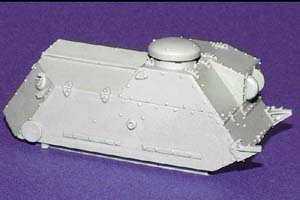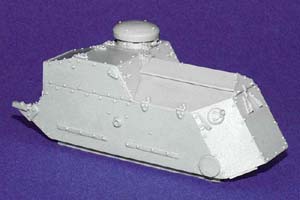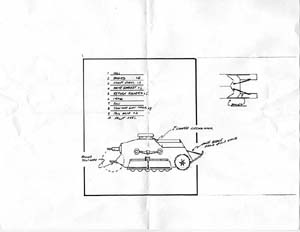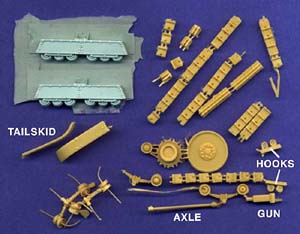Commander Series' 1/35 Ford 3-Ton Tank (1918)
By Karen Rychlewski
 |

 |
 Commander Series Models, Inc. of Rochester NY, produces an extensive line of ships in various scales and armored vehicles in 1/35. The primary components are resin cast and the kits often include white metal and photo-etched parts. Some include dry transfer markings. The casting quality can vary from excellent to potholed, but Commander has a 'customer satisfaction guarantee' and will replace the occasional part or kit which is less than ideal. I cannot comment on the ship kits, but the vehicle kits are sparse in the instructions department. These are kits intended for experienced modelers with deep sources of reference.
Commander Series Models, Inc. of Rochester NY, produces an extensive line of ships in various scales and armored vehicles in 1/35. The primary components are resin cast and the kits often include white metal and photo-etched parts. Some include dry transfer markings. The casting quality can vary from excellent to potholed, but Commander has a 'customer satisfaction guarantee' and will replace the occasional part or kit which is less than ideal. I cannot comment on the ship kits, but the vehicle kits are sparse in the instructions department. These are kits intended for experienced modelers with deep sources of reference. Onward to the box contents. The entire hull of the tank is one solid chunk of very nicely cast light grey resin. Edges, rivets, hinges, panel lines, and assorted bolted-on flanges are flawless, with sharp detail and no flash whatsoever, although the flat surfaces have a very slight 'sandpapery' texture; cleanup should be minimal. The entire bottom has a 1/16 inch 'platform' which I think needs to be removed--this will create a lot of resin dust but shouldn't be too difficult (just tedious) with a Dremel rotary file.
Onward to the box contents. The entire hull of the tank is one solid chunk of very nicely cast light grey resin. Edges, rivets, hinges, panel lines, and assorted bolted-on flanges are flawless, with sharp detail and no flash whatsoever, although the flat surfaces have a very slight 'sandpapery' texture; cleanup should be minimal. The entire bottom has a 1/16 inch 'platform' which I think needs to be removed--this will create a lot of resin dust but shouldn't be too difficult (just tedious) with a Dremel rotary file. Now the fun part: all the delicate little pieces for the rest of the track mechanism. The parts spread photo includes the parts for just one side. The front wheel, drive sprockets, return rollers, and track links are cast in a pale yellow resin to a much lower standard--which is unfortunate because these tiny parts will be quite difficult to clean up. Although the detail is good, there are some pits and missing flanges and the surfaces are distinctly rough with swirls, almost wrinkles, in addition to the pebbly texture. I doubt this can be passed off as replicating the metal surface; and it will be extremely difficult to smooth the surfaces without losing detail. Two extra pieces of the most delicate part, the return rollers, are supplied to compensate for breakage; and in fact two of the four return rollers were already broken when I opened the box. The track links are supplied in several pieces of varying lengths and a dozen or so individual links; this should make building the tracks more painless, but the track links share the problems described above. To make life easier, Commander includes an entire duplicate set of all pieces for both sides of the track unit, so you can happily break a few pieces and not have to make a frantic call in the middle of the night. Nice touch, Commander! The front axle, machine gun, several hooks, and a two-piece tail skid complete the kit parts; all of these are also cast in the yellow resin. There are no transfers included, as the tank apparently had no markings. Four tail skid braces will have to be easily scratched from strip stock.
Now the fun part: all the delicate little pieces for the rest of the track mechanism. The parts spread photo includes the parts for just one side. The front wheel, drive sprockets, return rollers, and track links are cast in a pale yellow resin to a much lower standard--which is unfortunate because these tiny parts will be quite difficult to clean up. Although the detail is good, there are some pits and missing flanges and the surfaces are distinctly rough with swirls, almost wrinkles, in addition to the pebbly texture. I doubt this can be passed off as replicating the metal surface; and it will be extremely difficult to smooth the surfaces without losing detail. Two extra pieces of the most delicate part, the return rollers, are supplied to compensate for breakage; and in fact two of the four return rollers were already broken when I opened the box. The track links are supplied in several pieces of varying lengths and a dozen or so individual links; this should make building the tracks more painless, but the track links share the problems described above. To make life easier, Commander includes an entire duplicate set of all pieces for both sides of the track unit, so you can happily break a few pieces and not have to make a frantic call in the middle of the night. Nice touch, Commander! The front axle, machine gun, several hooks, and a two-piece tail skid complete the kit parts; all of these are also cast in the yellow resin. There are no transfers included, as the tank apparently had no markings. Four tail skid braces will have to be easily scratched from strip stock.